
On August 16, 2015, my wife Rachel and I arrived in Puno, Peru by bus from Bolivia around 11:15am. The taxi to our hotel had to detour around road closures in the vicinity of the Plaza de Armas. After dropping off our luggage at our hotel, we walked to the plaza and found a military parade in progress. Ranks of soldiers marched carrying what looked like Kalashnikov rifles with fixed bayonets. Uniformed women were also in the parade but carried no visible weapons.
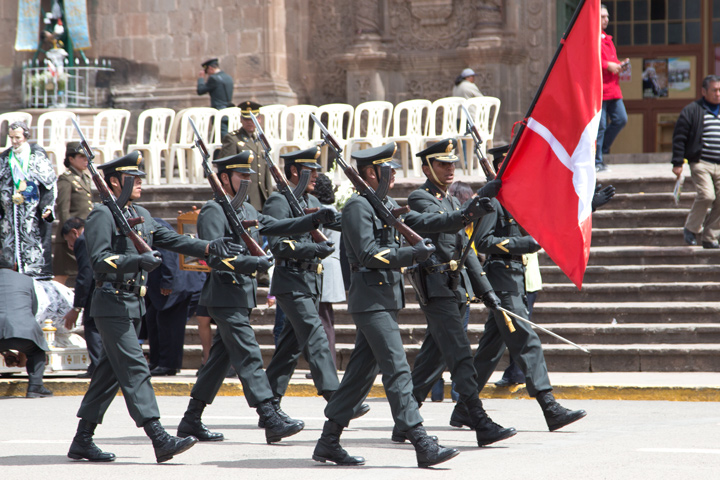
When we arrived, an officer was finishing up delivering a speech from a podium in front of the Catedral de Puno. Rachel queried a citizen watching the parade about what was going on. The woman seemed confused by the question, answering, “It’s Sunday.” We inferred that the parade was a weekly occurrence, which perhaps explained the modest crowed watching.
Months earlier, while planning our honeymoon, I came across a reference to a remarkable vessel docked in Puno that had long plied the waters of Lake Titicaca. Shared between Bolivia and Peru, Lake Titicaca is typically described as the highest lake navigable by commercial watercraft. The Yavari and her sister ship Yapura were ordered by the Peruvian government in 1861 and completed the following year. Designed as gunboats, these iron-hulled vessels were 30 meters (100′) in length. Prior to their assembly, their cannons were put to use elsewhere during the Chincha Islands War, so their careers were spent exclusively carrying cargo and passengers.
The real challenge was getting the vessels halfway around the world to a lake that sits some 3,800 m (about 12,500′) above sea level! For that reason, the vessels were broken down into kit form for later reassembly at Lake Titicaca. Further complicating matters was the fact that back then, there was no railroad between Lake Titicaca and the Pacific coast. As a result, each crate could only be as heavy as what a mule could carry! In June 1862, the pieces departed London for the Peruvian (now Chilean) port of Arica. From there, they were transported by rail to Tacna. The remaining 350 km (218 miles) journey by mule was the most difficult portion of the entire trek and the original contractor proved unequal to the task.
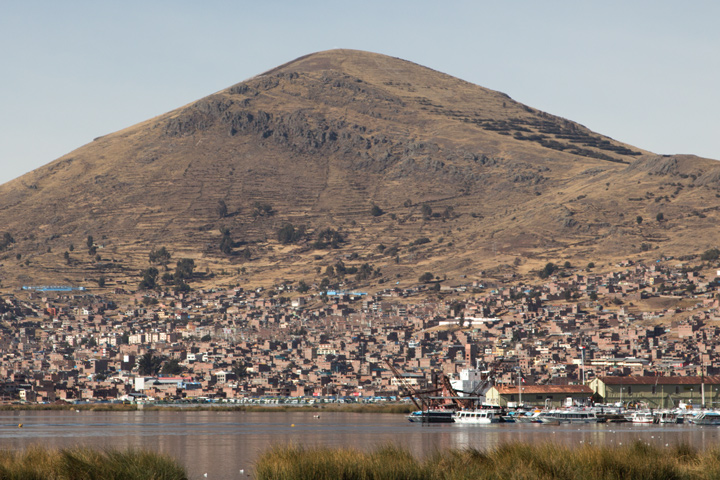
It wasn’t until 1869 that enough pieces of Yavari had arrived in Puno to begin assembly. This process took another two years and was done without the benefit of the ship’s plans, which had disappeared in transit to Peru. The ship was finally launched on Christmas Day, 1870. One additional challenge to overcome was determining how to fuel the 60 hp steam engine. There were no readily available local supplies of coal or wood, so the ship’s boiler’s were fueled with dried llama dung! (According to Meriel Larken, Yavari “needed 1,400 sacks to complete one circumnavigation” of Lake Titicaca! I am uncertain whether the improvised fuel source was capable of propelling the ship at its designed speed of 10 knots.) Sails supplemented the engine’s output.
Yavari‘s maiden voyage took place on June 14, 1871, almost nine years after its pieces left Great Britain. For more than a century, the vessel served on the lake, principally under the control of the Peruvian Navy and the Peruvian Corporation. It only kept the dung-powered engines until 1914 the ship’s hull was lengthened and its steam engine replaced with a more modern engine that still powers the vessel.
Perhaps due to the improved state of roads in the Lake Titicaca area, the ship fell into disuse by the mid-1970s. In 1987 a private effort led by Meriel Larken raised $5,000 to purchase Yavari. A lengthy restoration process followed which, happily, is now virtually complete. At times (though not during our visit to Puno) the ship is even available for overnight stays as a bed and breakfast.

At the front desk of our hotel, we asked for a taxi to the Yavari. The desk clerk called a taxi and wrote down the name of a hotel at the north end of Puno Bay, Sonesta Posadas Del Inca, where the Yavari was supposed to be docked. To my disappointment, the ship’s berth was empty. A staff member at the hotel advised that the ship had departed but he didn’t know its destination. The trip wasn’t entirely a wasted effort. We did get a distant view of the SS Coya, another vessel with a similar story. It was built in Scotland, disassembled, shipped overland to Lake Titicaca, and launched in 1893. After renovations it hosted a restaurant, although I am uncertain whether this is still the case.

Another pleasant surprise was the fact that the hotel grounds were inhabited by adorable furry creatures which a lady at the front desk told us were cuy (guinea pigs). The rodent originated in the Andes rather than Guinea, and is considered a delicacy.

I suggested to Rachel that we take a walk at the Puno waterfront on the west end of the bay. A taxi dropped us off there accordingly. The waterfront featured a marketplace, a lighthouse, a long breakwater, and a marina hosting a substantial flotilla of small vessels.
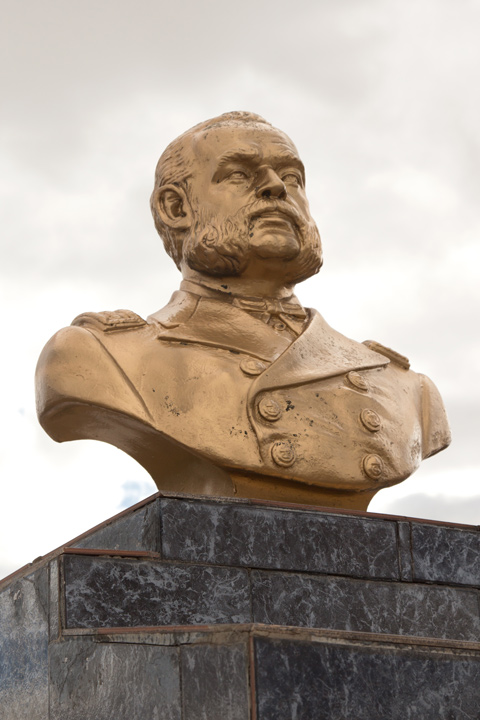
The waterfront also houses a memorial to Admiral Miguel Grau, the mutton chop-sporting “Peruvian of the Millennium”. During the War of the Pacific in 1879, he led the ironclad Huáscar in a series of raids that befuddled the more powerful Chilean fleet and temporarily prevented them from launching an invasion of Peru. Grau’s reputation for tactical genius perhaps owes much to the initially poor performance of his Chilean opponents.
On the other hand, the historical record does support Grau’s reputation for chivalry, for which he was supposed to have received the nickname “Gentleman of the Seas”. His treatment of enemy survivors whose ships he sank or captured was impeccable, making him stand in sharp contrast to other naval leaders during the conflict whom committed such outrages as launching indiscriminate bombardments of coastal cities. In one incident, Huáscar snuck up on a Chilean collier in port. Instead of opening fire, Grau signaled them to surrender. The arrival of Chilean reinforcements—alerted by a warning shot—forced Grau to flee without his prize, though the collier’s captain later shipped Grau some wine as thanks for not simply blowing him out of the water. Grau was eventually killed in battle and his vessel captured; Huáscar is now a museum ship in Talcahuano, Chile.
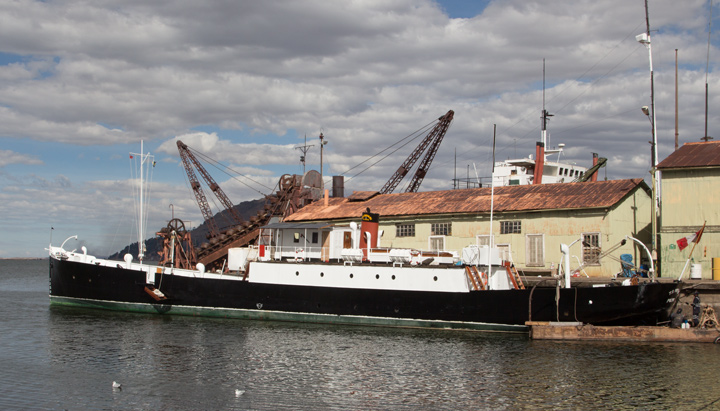
Not far from the Grau memorial, I was surprised to see an old vessel at dock. Indeed, the ship’s diminutive funnel read “M/N YAVARI PU-21926-ML” and its life rings “YAVARI 1862”. Yavari had left her original dock by the Coya, but it turned out that she had not traveled very far! A crew of workers—dressed in Yavari coveralls or jackets decorated with both the Peurvian flag and the Union Jack—were applying a fresh coat of black paint to the stern.
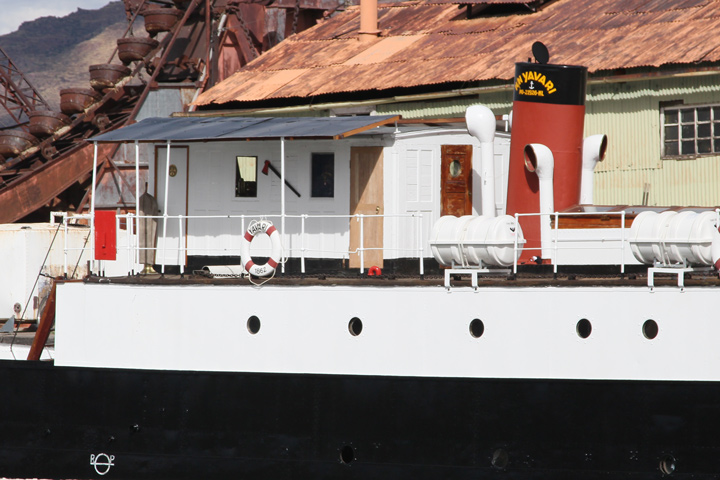
The proud old vessel looked to be in great shape, a tribute to the dedication of the people who’d spent so much time restoring it. Rachel was less impressed, remarking that the Yavari‘s story was way more interesting than the ship itself. She grudgingly admitted that seeing the work in progress was interesting. I wish now that I’d called across the water to the workers and asked them if it was possible to take a tour. At the time, the gate to the dock was closed and I assumed it simply wasn’t possible to visit. Currently, the Yavari website does say the ship is open to the public daily during restoration. During my next visit to Peru, I hope Yavari will be open again for overnight stays…or better yet, cruises on Lake Titicaca.
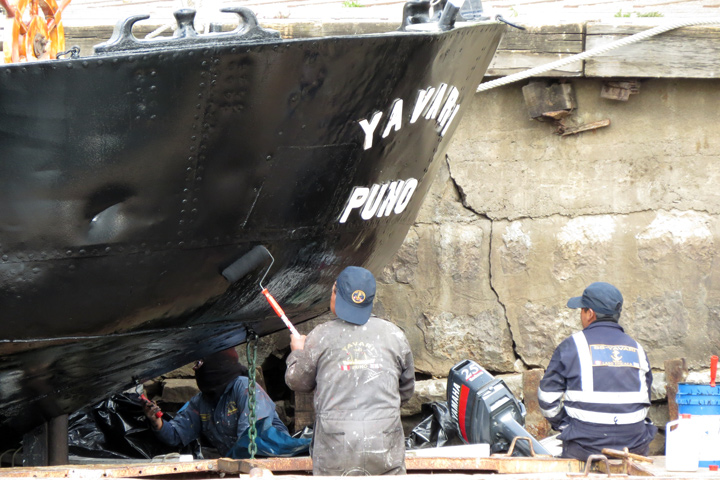
Further Reading
The Ship, the Lady and the Lake by Meriel Larken, a book about her adventures in South America and efforts to purchase and restore the Yavari. This source is the basis for most of this post’s account of the Yavari‘s history.
Yavari 1862, a website with a brief history of the ship and restoration efforts as well as an impressive photo gallery; it was improved considerably after my visit.
Andean Tragedy: Fighting the War of the Pacific, 1879-1884 by William F. Sater, a book which includes an account of Grau’s naval campaign.

Great post and photos. I ate cuy quite a few times when I was travelling in the Andean parts of Perú. I’ll always remember my stay in Puno for experiencing one of the coldest nights ever on my trip across South America. During the day it was fine but suddenly at night the temperature dropped about 30 degrees. I was staying at one of those cheap hospedajes without heating and I slept in all my clothes and used all the blankets I could find. But I had a hell of a time travelling around that part of the world. Perú and Bolivia are real ‘adventure’ countries. I am going to take the time to read more of your posts as I like your blog very much
LikeLike
Thanks for your kind words. It definitely does get cold at that altitude. Our hostel in Copacabana was unheated and frigid at night. The hot water bottles they provided were a lifesaver.
LikeLiked by 1 person